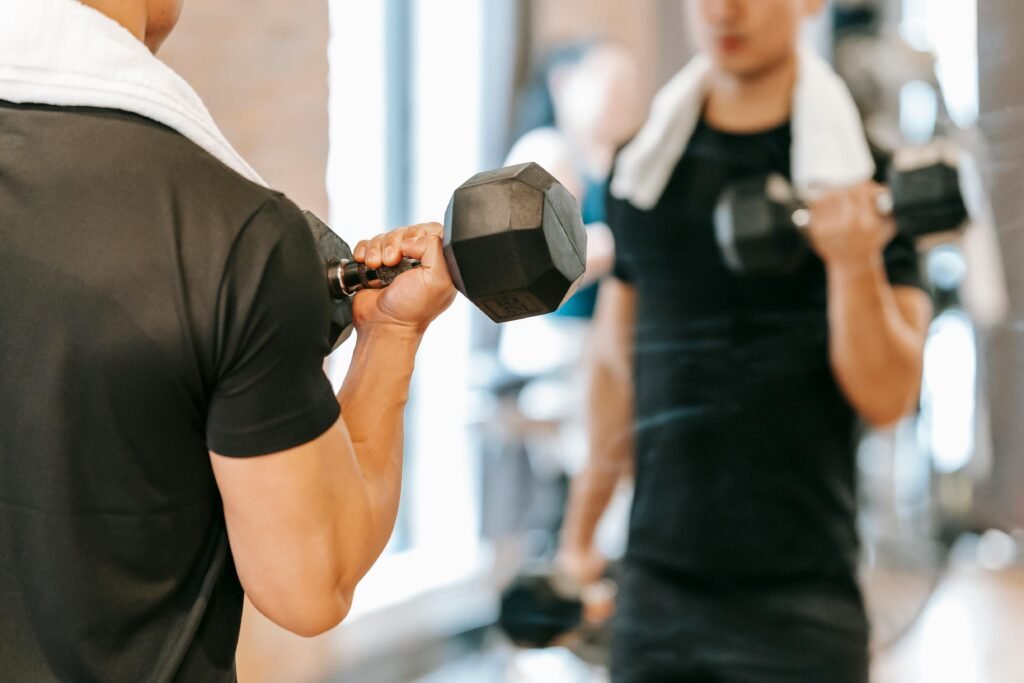Hello Fitness enthusiasts! Before going to gym after watching some random traditional workout video on YouTube hold on a second! You still need to learn something more. The gym floor has traditionally been a battleground of stereotypes. At one end, we have the image of the hulking, muscle-bound man, grunting through heavy lifts. At the other, the delicate woman, focusing on cardio and light weights to avoid “bulking up.” It’s time to dismantle these misconceptions and explore the fascinating differences in men and women strength training.

- Physiological Differences
- Hormonal Differences
- Psychological Differences
- Practical Differences in Training Approaches
- The Role of Nutrition
- Addressing Common Myths
- Creating a Balanced Training Program
💁Understanding the Physiological Differences
While the gym floor is a melting pot of diverse fitness goals, there are undeniable physiological differences between men and women that influence their strength training experiences. These differences are not barriers, but rather factors to consider when crafting personalized workout routines. Let’s delve into the key physiological disparities.
Men, Women, and Muscles: Let’s Break It Down!
Why are guys often more muscular?
It’s all about hormones! Men have a special hormone called testosterone that helps their muscles grow bigger and stronger. It’s like a supercharger for their muscles! So, when guys start lifting weights, their muscles can respond really well to the workouts and get bigger faster.
Can women build muscle too?
Absolutely! Women can definitely build amazing muscle. While they don’t have as much of that muscle-building hormone, it doesn’t mean they can’t get strong and toned. It just might take a little different approach. Women can sculpt fantastic bodies with the right workouts and nutrition.
Guys and girls store fat in different spots!
Men: Men tend to store fat primarily in the abdominal region. This type of fat storage, known as visceral fat, is closely associated with metabolic health risks but is also more easily mobilized for energy during exercise.
Women: Women typically store fat in the hips, thighs, and buttocks. This subcutaneous fat is less associated with metabolic health risks and is harder to lose through exercise. This difference in fat distribution means women might have different conditioning and endurance needs compared to men.
Muscle Fibers: The Power Players
Imagine your muscles are made up of tiny superheroes. Some are speedy and strong, while others are more like endurance champs!
- Guys: Often have more of those speedy, powerful superheroes. Men have a higher proportion of Type II (fast-twitch) muscle fibers, which are more suited for explosive power and strength. They’re great for lifting heavy things for fewer repetition. Think Superman!
- Girls: Tend to have more of the endurance superheroes. Women tend to have a higher proportion of Type I (slow-twitch) muscle fibers, which are more suited for endurance and continuous activities. This makes women generally better at sustaining exercises for longer periods. They’re amazing at keeping going for a long time. Like Wonder Woman, but with muscles!
So, this is why guys might be better at lifting heavy weights, while girls often shine in exercises that need you to keep going. But remember, everyone is different, and you can train to be strong and powerful no matter what kind of superheroes you have in your muscles!
Bone Density
Bones aren’t just for show! They’re your body’s framework, keeping you upright and protecting your vital organs. But just like muscles, bones need exercise to stay strong.
Why are women extra careful? Women are more likely to get osteoporosis, a condition where bones become weak and break easily. This is often linked to changes in hormones as women get older.
The good news? Strength training is a fantastic way for everyone, especially women, to keep bones healthy and strong. Lifting weights helps to build bone density, making them less likely to break. So, whether you’re a man or a woman, adding some weightlifting to your routine is a great way to take care of your bones!
💁♀️Hormones: The Body’s Secret Strength Coaches
Hormones are like tiny messengers that tell your body what to do. And when it comes to building muscle, they play a major role! Let’s break down how these hormonal superheroes work differently for guys and girls.
Testosterone: The Muscle Builder
- Guys: Testosterone is like a muscle-building superhero for guys! It helps their muscles grow bigger and stronger. It’s also great for repairing muscles after a tough workout. Think of it as the secret ingredient for those impressive gains.
- Girls: While girls have less testosterone, it’s still important. It helps with muscle growth too, but it’s not as powerful as the testosterone boost guys get. Don’t worry though, girls can still build amazing strength and muscle!
Estrogen: The Bone Protector
- Guys: Guys have less estrogen, which is why they might be more prone to injuries around their joints. Estrogen helps keep joints healthy and flexible.
- Girls: Estrogen is a bone’s best friend! It helps keep bones strong and healthy, which is super important for preventing osteoporosis. That’s why it’s extra crucial for girls to do exercises that strengthen their bones.
Remember, while hormones play a part, everyone is different! The most important thing is to find workouts you love and listen to your body.
Want to know more about how these hormonal differences affect workouts?
🕵️Psychological Differences: The Mind-Muscle Connection
It’s not just about what you do in the gym; it’s also about what’s going on in your head! Let’s talk about how guys and girls might think differently about their workouts.
Goal Getter: What Are You Aiming For?
- Guys: Often, guys like to focus on getting bigger and stronger. They love lifting those heavy weights and seeing their muscles grow. It’s like building their own personal superhero body!
- Girls: Girls often have a mix of goals. They might want to be toned, have more energy, or just feel good in their own skin. It’s less about getting huge and more about feeling strong and healthy.
Motivation Station: What Gets You Going?
- Guys: Many guys find motivation in competition and pushing themselves to the limit. They might love the challenge of lifting heavier and heavier weights.
- Girls: Girls often find motivation in different places. Some like the social aspect of group fitness classes, while others focus on how exercise makes them feel. Looking and feeling good can be a big motivator too!
Remember, these are just general trends. Everyone is different, and the best workout is the one you enjoy!
Want to know how these differences can affect your workout routine?
🙎♂️Practical Differences in Men And Women Strength Training Approaches
Exercise Selection
Men: Men’s workouts often include compound movements that target multiple muscle groups, such as bench presses, squats, deadlifts, and overhead presses. These exercises are effective for building overall strength and muscle mass.
Women: Women’s workouts might incorporate a greater variety of exercises, including both compound and isolation movements. Exercises such as lunges, leg presses, and various resistance band exercises are commonly included to target specific areas like the glutes, thighs, and core.
Volume and Intensity
Men: Men typically use higher weights with lower repetitions (e.g., 3-5 sets of 6-8 reps) to maximize muscle growth and strength. They might also incorporate more progressive overload, continuously increasing the weights they lift.
Women: Women often use lighter weights with higher repetitions (e.g., 3-4 sets of 12-15 reps) to enhance muscle endurance and tone. While progressive overload is still important, the increments in weight might be smaller compared to men’s routines.
Recovery and Rest Periods
Men: Men usually take longer rest periods between sets (e.g., 2-3 minutes) to allow for maximum recovery and strength output in each set. This approach is beneficial for heavy lifting and muscle growth.
Women: Women might take shorter rest periods (e.g., 30 seconds to 1 minute) to keep the heart rate elevated and enhance calorie burn. This approach supports endurance and can be more time-efficient.
🏃♂️Cardio Integration
Men: Cardio is often less emphasized in men’s strength training routines. When included, it is typically high-intensity interval training (HIIT) or low-intensity steady-state (LISS) cardio to complement strength gains without compromising muscle mass.
Women: Cardio plays a more significant role in women’s fitness routines. Women might incorporate more steady-state cardio, group classes, and HIIT sessions to support fat loss and cardiovascular health alongside strength training.
🍴The Role of Nutrition
Macronutrient Needs
Men: Men generally require higher caloric intake and protein levels to support their muscle-building goals. A diet rich in protein, complex carbohydrates, and healthy fats is essential to fuel their workouts and promote muscle repair and growth.
Women: Women’s caloric needs might be slightly lower, and their focus could be on balanced macronutrient intake to support overall health, lean muscle development, and fat loss. Adequate protein is still crucial, but women might also emphasize nutrient-dense foods that provide vitamins and minerals.
Supplements
Men: Men might use supplements like protein powder, creatine, and pre-workout formulas to enhance performance and muscle growth. These supplements support the high demands of intense strength training.
Women: Women may also use protein supplements, but might be more inclined towards supplements that support overall wellness, such as multivitamins, BCAAs (branched-chain amino acids), and collagen. Supplements for joint health and recovery are also popular.
🙅♀️Addressing Common Myths
Myth 1: Lifting Heavy Makes Women Bulky
Reality: Women generally do not produce enough testosterone to bulk up like men. Lifting heavy can help women build lean muscle, increase strength, and improve overall body composition without becoming overly muscular.
Myth 2: Men Shouldn’t Do High Reps
Reality: High-rep training can be beneficial for men as well, particularly for endurance, conditioning, and muscle hypertrophy. Including a variety of rep ranges can lead to more balanced muscle development and performance.
Myth 3: Cardio is More Important for Women
Reality: While cardio is beneficial for heart health and fat loss, strength training is equally important for women. It helps in building lean muscle, boosting metabolism, and enhancing overall fitness. A balanced approach that includes both cardio and strength training is optimal for both genders.
Creating a Balanced Training Program
For Men
- Focus on Compound Movements:
- Include exercises like squats, deadlifts, bench presses, and overhead presses.
- Aim for heavy weights with lower repetitions (3-5 sets of 6-8 reps).
- Incorporate Progressive Overload:
- Gradually increase the weights you lift to continue challenging your muscles.
- Include Accessory Work:
- Balance Strength with Conditioning:
- Include HIIT or LISS cardio sessions to support cardiovascular health and endurance.
- Prioritize Recovery:
- Allow sufficient rest between sets and include rest days in your routine to prevent overtraining and injuries.
For Women
- Emphasize Variety:
- Include a mix of compound and isolation exercises to target different muscle groups.
- Use a combination of weights, resistance bands, and bodyweight exercises.
- Focus on Form:
- Prioritize proper form and technique over lifting heavy weights to prevent injuries and maximize effectiveness.
- Include Functional Training:
- Incorporate exercises that improve overall functionality and everyday movements, such as lunges, planks, and kettlebell swings.
- Combine Strength and Cardio:
- Integrate cardio sessions, such as steady-state or HIIT, alongside strength training for a balanced fitness approach.
- Support with Nutrition:
- Ensure adequate protein intake and focus on nutrient-dense foods to support muscle recovery and overall health.
Conclusion
While the fundamental principles of strength training are the same for both men and women, the differences in physiology, hormones, and preferences necessitate tailored approaches. Men typically focus on gaining muscle mass and strength with heavier weights and lower repetitions, while women often emphasize toning, endurance, and balanced fitness routines with lighter weights and higher repetitions. Understanding these differences can help both genders create effective and enjoyable workout programs that cater to their unique needs and goals.
Remember, the key to successful strength training lies in consistency, proper nutrition, and listening to your body. Whether you’re a man or a woman, the journey to strength and fitness is a personal one, and finding what works best for you is essential. Stay motivated, stay committed, and enjoy the process of becoming stronger and healthier.
Feel free to comment below if you have any questions or if you’d like to share your own experiences with strength training. We love hearing from our community and supporting each other on our fitness journeys!




Wonderful web site Lots of useful info here Im sending it to a few friends ans additionally sharing in delicious And obviously thanks to your effort
F*ckin’ awesome issues here. I am very happy to look your article. Thanks so much and i am looking forward to touch you. Will you please drop me a mail?